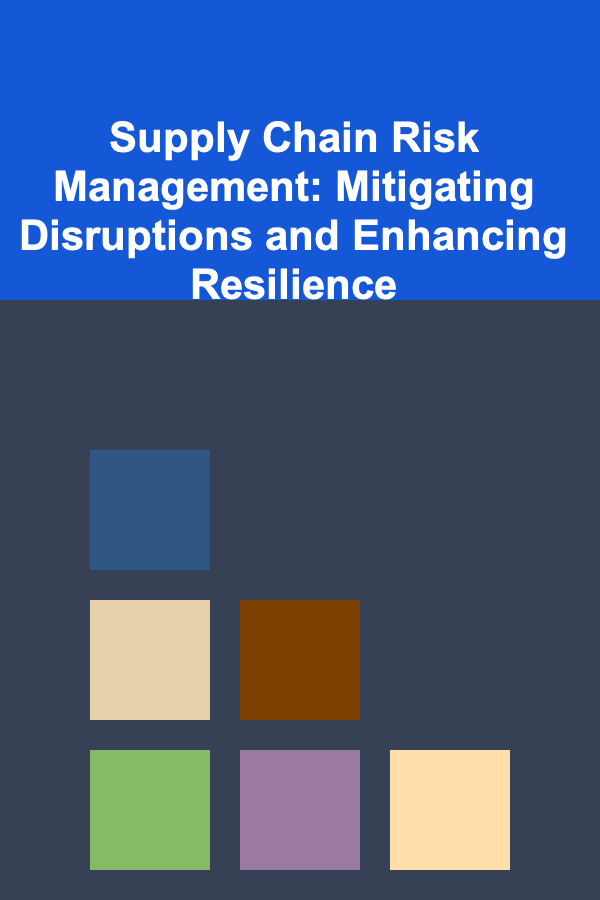
Supply Chain Risk Management: Mitigating Disruptions and Enhancing Resilience
ebook include PDF & Audio bundle (Micro Guide)
$12.99$7.99
Limited Time Offer! Order within the next:

Supply chains are the backbone of modern business operations, supporting the flow of goods, services, and information. However, these systems are vulnerable to various risks, ranging from natural disasters to geopolitical issues and technological failures. Effective supply chain risk management (SCRM) is crucial for ensuring that a business remains resilient and adaptable in the face of disruptions. In this actionable guide, we will explore the key principles and strategies for mitigating supply chain risks, enhancing resilience, and maintaining operational continuity.
Understanding Supply Chain Risks
Supply chain risks can be categorized into several types, each of which can affect the flow of goods or services in different ways. These risks can arise from internal processes, external factors, or disruptions in the global network.
Types of Supply Chain Risks
- Operational Risks: These arise from internal processes, inefficiencies, or system failures. For example, delays in production, transportation bottlenecks, or errors in inventory management fall under this category.
- Strategic Risks: These are related to long-term decisions, such as supplier selection, geographic location of suppliers, and market strategy. Poor supplier relationships or a lack of diversification can result in strategic vulnerabilities.
- Financial Risks: These include risks related to fluctuating exchange rates, cost increases, or payment defaults. Global supply chains are particularly susceptible to financial risk due to the wide variation in market conditions and currency values.
- External Risks: External factors such as natural disasters, pandemics, political instability, or regulatory changes can cause significant disruptions. These risks are harder to predict but can have severe impacts on supply chain performance.
- Reputational Risks: Poor supply chain practices or failures can harm a company's reputation, especially if consumers become aware of unethical practices, environmental impacts, or product quality issues.
- Cybersecurity Risks: As businesses become more reliant on digital tools and systems, cyberattacks or data breaches pose significant threats to supply chain operations.
Understanding the various categories of risk is crucial to managing them effectively. Companies that do not have a clear risk management plan in place expose themselves to potential disruptions that could affect their bottom line and long-term sustainability.
Key Strategies for Mitigating Supply Chain Risks
1. Risk Identification and Assessment
The first step in mitigating risks is identifying them. This requires a comprehensive analysis of your entire supply chain, from suppliers and manufacturers to logistics providers and end customers. A thorough risk assessment allows you to understand where vulnerabilities lie, how likely they are to occur, and their potential impact on the business.
Steps for Effective Risk Assessment:
- Mapping the Supply Chain: Create a detailed map of your supply chain, identifying all suppliers, manufacturers, transportation routes, and distribution networks. This will help pinpoint critical nodes and potential choke points.
- Risk Scoring: Once risks are identified, assess each one by determining its likelihood and potential impact. For example, risks like natural disasters might be less frequent but can have a high impact, while operational inefficiencies may occur more frequently but have lower consequences.
- Scenario Planning: Consider different risk scenarios and their possible outcomes. This allows you to develop contingency plans and prepare for worst-case scenarios.
- Regular Risk Audits: Conduct periodic reviews of your supply chain to update risk assessments based on changing conditions such as new suppliers, technological advancements, or market shifts.
By conducting a thorough risk assessment, companies gain a clearer understanding of where to focus their efforts and which areas of the supply chain need immediate attention.
2. Building a Diversified Supply Chain
One of the most effective ways to mitigate supply chain risks is by diversifying suppliers and logistics providers. Relying on a single supplier or transportation route increases the likelihood of a complete disruption in case of a crisis.
Key Approaches to Diversification:
- Geographical Diversification: Avoid relying on suppliers or manufacturers located in a single region or country. Natural disasters, political instability, or economic downturns in one region can disrupt the entire supply chain. By sourcing from multiple geographic locations, you can reduce the risk of regional disruptions.
- Supplier Diversification: Work with a range of suppliers for critical components. This reduces the risk of relying on one supplier, particularly in industries where demand surges or sudden shortages can occur.
- Alternative Transportation Routes: In addition to diversifying suppliers, consider alternative transportation routes. For example, if the primary shipping route faces disruption, having an alternative route ready can help maintain the flow of goods.
- Multiple Sourcing Options: For critical components, consider dual sourcing (i.e., having two suppliers for the same item) to avoid reliance on a single supplier. This increases flexibility and reduces the chance of stockouts.
Diversification reduces the risks associated with a single point of failure, enhancing overall supply chain resilience.
3. Enhancing Supplier Relationship Management
A strong, transparent relationship with suppliers is essential to mitigating risks. When suppliers fail to meet expectations or experience disruptions, the entire supply chain is impacted. Building strategic partnerships with suppliers helps manage risks and ensures that the supply chain remains resilient during challenging times.
Strategies for Supplier Risk Management:
- Collaborative Communication: Maintain open lines of communication with your suppliers, especially regarding potential issues that could impact their ability to deliver on time. Collaborative discussions can help identify potential risks early, allowing for prompt action.
- Supplier Audits: Regularly audit suppliers to ensure that they are adhering to quality, financial, and operational standards. This includes reviewing their own risk management practices, such as disaster recovery plans and financial stability.
- Performance Monitoring: Continuously monitor supplier performance using KPIs such as on-time delivery, quality, and production capacity. This will help you identify potential risks before they materialize.
- Contract Clauses: Include risk mitigation clauses in contracts, such as penalty clauses for missed deliveries or agreed-upon response times in case of a supply chain disruption. Additionally, ensure that you have clear terms for crisis management and escalation procedures.
Building and maintaining strong relationships with suppliers not only mitigates risks but also ensures that suppliers are motivated to work collaboratively toward overcoming disruptions.
4. Developing a Robust Contingency and Crisis Management Plan
Even with the best risk mitigation strategies in place, disruptions are inevitable. The key to managing these disruptions effectively is having a well-prepared contingency and crisis management plan.
Steps to Develop a Crisis Management Plan:
- Define Critical Risk Scenarios: Based on your risk assessment, identify the most likely and impactful disruptions (e.g., natural disasters, supply shortages, cyberattacks) and develop specific contingency plans for each.
- Crisis Response Team: Designate a crisis response team with clear roles and responsibilities. This team should include members from various departments, including procurement, logistics, legal, and finance, to ensure comprehensive decision-making during a crisis.
- Alternative Suppliers and Routes: Identify backup suppliers, manufacturers, and transportation routes that can quickly take over if primary sources face disruption.
- Business Continuity Plans: Develop business continuity plans that ensure minimal operational disruption. This includes ensuring that IT systems are backed up, that key staff have contingency protocols in place, and that production can be maintained at an alternative location if necessary.
- Testing and Simulation: Regularly conduct drills and simulations to test your contingency plan. By running mock disruptions, you can identify weaknesses in your plan and improve its effectiveness.
Having a robust crisis management plan allows companies to respond swiftly and effectively when disruptions occur, minimizing damage to operations.
5. Leveraging Technology and Data Analytics
Technology is transforming how companies manage supply chain risks. Real-time data, advanced analytics, and digital tools enable businesses to detect potential disruptions early and make informed decisions.
Technological Solutions for Risk Management:
- Supply Chain Visibility Platforms: Implement end-to-end supply chain visibility tools that provide real-time tracking of goods, suppliers, and inventory levels. These platforms help identify potential risks and delays, enabling businesses to take preemptive action.
- Predictive Analytics: Use predictive analytics to forecast potential supply chain disruptions based on historical data, market trends, and external factors. This allows you to prepare for disruptions before they occur.
- Blockchain for Transparency: Blockchain technology can be used to create a transparent and immutable record of transactions across the supply chain. This enhances traceability and accountability, helping to identify potential risks in the supply chain.
- Automation and AI: Use AI-driven tools to automate supply chain processes, such as demand forecasting, inventory management, and route optimization. Automation improves efficiency, reduces human error, and helps respond quickly to disruptions.
Integrating technology into supply chain management improves risk detection, mitigation, and response times, ultimately enhancing resilience.
Conclusion
Supply chain risk management is a critical aspect of maintaining a resilient and adaptable business. By identifying and assessing risks, diversifying suppliers, building strong relationships, developing contingency plans, and leveraging technology, businesses can mitigate disruptions and enhance their supply chain's resilience. While it's impossible to eliminate all risks, a proactive approach to risk management can significantly reduce their impact and ensure that your business remains operational even in the face of uncertainty.
By implementing these strategies, companies not only protect themselves from immediate disruptions but also build a more flexible and sustainable supply chain that can thrive in the face of future challenges.

Criminology: Understanding Crime and Its Causes
Read More
Exploring Affordable Alternative Transportation Options for Commuters
Read More
How to Create Compelling Content for Your Automotive and DIY Blog
Read More
How to Use Digital Notes Apps for Better Organization
Read More
How to Understand Quantum Computing for Cybersecurity Threats
Read More
Understanding ISO for Low Light Photography: A Deep Dive
Read MoreOther Products

Criminology: Understanding Crime and Its Causes
Read More
Exploring Affordable Alternative Transportation Options for Commuters
Read More
How to Create Compelling Content for Your Automotive and DIY Blog
Read More
How to Use Digital Notes Apps for Better Organization
Read More
How to Understand Quantum Computing for Cybersecurity Threats
Read More